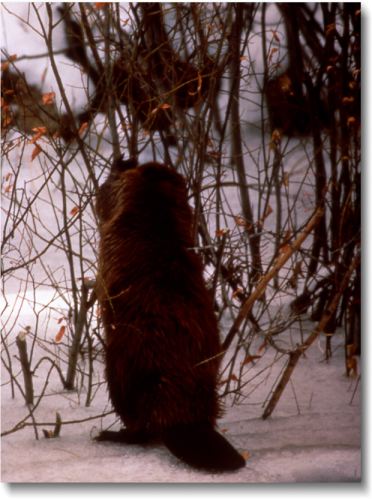
Vital Statistics
Taxonomic Hierarchy [144]Kingdom: Animalia -- Animal, animals, animaux
Phylum: Chordata -- chordates, cordado, cordés
Subphylum: Vertebrata -- vertebrado, vertebrates, vertébrés
Class: Mammalia Linnaeus, 1758 -- mamífero, mammals, mammifères
Subclass: Theria Parker and Haswell, 1897
Infraclass: Eutheria Gill, 1872
Order: Rodentia Bowdich, 1821 -- esquilo, preá, rato, rodents, roedor, rongeurs
Suborder: Sciuromorpha Brandt, 1855 -- squirrels
Family: Castoridae Hemprich, 1820 -- beavers
Genus: Castor Linnaeus, 1758 -- beavers
Species: Castor canadensis Kuhl, 1820 -- american beaver, beaver,
Body length: 3 ft. (.9 m) [145]
Height at the shoulders: 15 in. (38 cm) [146]
Weight: 35 to 66 lbs. (16 to 30 kg) (Heaviest on record was found in Wisconsin: 110 lbs. (49.9 kg)) [147] [148]
Fur color: Overall brown. The outer layer consists of coarse, long, glossy guard hairs which vary in color from yellowish brown to reddish-brown to black. Their underfur consists of dense, short, fine hairs that are grayish to brown. The underside of the animal is paler. [149]
Tail length: 1 ft. (30 cm) [150]
Tail width: 6 in. (15 cm) [151]
Tail color: Black. [152]
Time a beaver can spend underwater: 10 to 15 minutes per breath. [153]

Image Source: dcJohn / License under Creative Commons 2.0
The
Head: Beavers have a large, wide head. [154] While submerged, the ears
and nostrils have valves that close to prevent water entry. [155] Fur
lined lips close to form a seal behind their teeth, allowing them to
hold their breath while they cut, peel, or carry branches underwater.
[156] Their eyes are protected by a third eyelid called a nictitating
membrane. [157] These transparent eyelids protect the beavers' eyes
while still allowing them to see. [158] As with all rodents, a beavers'
teeth grow continually during their life. [159] Their teeth are
self-sharpening because of a hard orange enamel on the outer side and a
softer inner side that wears more slowly. This wear pattern creates a
chisel shape. [160] The outer enamel is orange because iron has
replaced calcium. This makes them unusually strong, even among rodents.
[161]
The Feet: Beavers walk plantigrade, or flat-footed. All
of their feet have five digits. The tracks left by the front feet will
usually be 2 to 3 in. (5 to 7.6 cm) long, and show only four digits.
The fifth digit will sometimes register, but not always. The back feet
have webbing connecting the toes, and are used for paddling. The tracks
left by the hind feet will usually be 6 to 7 in. (15.24 to 17.78 cm)
long, and show five digits. [162]

A beaver eating in the snow.
Image Source: NPS Photo
The Tail: Broad, black, scaly, and flat. Its length is about 1 ft. (30 cm) [163] with a width of about 6 in. (15 cm). [164] A beaver's tail serves several functions. It is used as a rudder while swimming, as a third leg while standing upright, as a lever when dragging branches, as a warning signal when slapped on the water, and as a place for the body to store fat for the winter. [165] [166] It is said to taste very good, and at one time was considered a delicacy. [167]
Copyright © 2007 Beaver Pictures & Facts
Member of Fohn.net
Image Source for beaver lodge at top of page: M. LeFever, U.S. Fish and Wildlife Service.
Image Source for two beaver at bottom of page: Tom Smylie, U.S. Fish and Wildlife Service.

